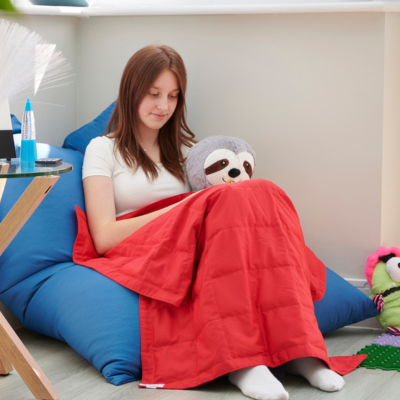Get exclusive deals you won't find anywhere else straight to your inbox.

Helping Children With Sensory Overload In The Classroom
This blog focuses on helping children with sensory overload in the classroom. Every child deserves an inclusive and supportive learning environment where they can thrive academically and emotionally. However, for some children, the sensory stimuli in a bustling classroom can be overwhelming, leading to sensory overload. Sensory overload can disrupt a child's ability to learn, interact with peers, and feel comfortable in their educational setting. In this article, we will explore what sensory overload is, its signs and symptoms, and practical strategies that educators, parents, and caregivers can use to help children manage and thrive in the classroom.
Understanding Sensory Overload
Sensory overload occurs when a child's sensory system becomes overwhelmed by the information it receives from their environment. Children with sensory processing difficulties, autism spectrum disorders, ADHD, or other sensory-related conditions are more prone to experiencing sensory overload. The sensory system encompasses all the ways we process information from our surroundings, including sight, sound, touch, taste, and smell. In a classroom, various sensory stimuli, such as bright lights, loud noises, crowded spaces, and strong smells, can trigger sensory overload.
Signs and Symptoms
Recognizing the signs and symptoms of sensory overload in a classroom setting is crucial for timely intervention.
- Heightened Anxiety - children may become anxious or agitated when sensory stimuli overwhelm them. They may display increased fidgeting, restlessness, or signs of distress.
- Irritability - sensory overload can make children irritable or easily frustrated. They may have difficulty staying focused and may lash out at peers or adults.
- Avoidance Behaviour - children may try to avoid sensory triggers by covering their ears, closing their eyes, or moving away from the source of discomfort.
- Physical Symptoms - sensory overload can manifest in physical symptoms. This could be headaches, stomach aches, or increased heart rate.
- Difficulty Concentrating - children may have trouble concentrating on tasks or lessons due to sensory distractions, which can hinder their learning and academic progress.
Strategies to Help Children with Sensory Overload
Create a Sensory-Friendly Classroom Environment
Dim the lights, use soft, natural lighting or sensory lighting. Well thought out sensory lights can help with mood regulation and create a calm , relaxed environment, conducive for learning. Sensory lights come in a variety of shapes, sizes and functions. Bubble Tubes or colourful light projectors create an overall calming environment for everyone to enjoy. Smaller, portable hand-held lights can be used by individuals to re-focus and get back on task.

Reducing clutter and creating organised spaces helps to calm individuals who might be sensitive to busy environments. Having specific homes or areas for classroom resources can help to build structure and familiarity, which can again calm busy minds.
Ear defenders or ear buds are particularly helpful in reducing distressing or loud noises. This can create a more comfortable environment to work in. Good quality ear defenders, are available in a range of colours and can be fully adjusted to git a child (from 12 months+) to adult. For those who may be more fashion conscious or want to wear something more discreet, sensory ear plugs are an effective solution.
Children who have heightened anxiety are more prone to fidgeting. Providing quality fidget toys like stress balls or putty can help children self-regulate and improve focus.
Implement Sensory Breaks
Schedule short sensory breaks throughout the day to allow children to decompress. Offer a sensory corner or designated space where children can retreat when feeling overwhelmed. Use tools such as bubble tubes and bubble walls to create a calm environment. If space is limited, try a pop up sensory den. This can be easily put in the corner of a classroom or dedicated space and then removed and stored when not in use. Use sensory lights, projectors and hand held lights inside the den to really help realx and calm.
Use Visual Supports
Visual schedules and cues can help children anticipate transitions and reduce anxiety. Communication fans and visual timetable are ideal for enabling children with non verbal autism to express feelings and emotions, which is key to managing emotions and expectations. Visual timers can assist in managing time expectations.
Encourage Self-Advocacy
Teach children to recognise their sensory triggers and advocate for themselves by using predetermined strategies such as using weighted blankets, brushes and putty. Encourage them to communicate their needs to teachers and peers.
Flexible Seating Options
Allow for flexible seating arrangements, such as standing desks, wobble stools, or alternative seating options. Ensure seating arrangements consider each child's sensory preferences. Desk screens can help to keep children focussed and wobble cushions can help to reduce excessive fidgeting.

Establish Sensory-Friendly Routines
Consistency in routines can help children feel more secure in the classroom. Use a calm and reassuring tone when giving instructions or redirections.
Collaborate with Occupational Therapists
Involve occupational therapists who specialise in sensory integration to create individualised plans and strategies.
Education and Awareness
Educate teachers, students, and parents about sensory processing difficulties and sensory overload. Foster empathy and understanding among peers to create an inclusive classroom environment.
Conclusion
Helping children with sensory overload in the classroom requires patience, empathy, and a collaborative effort between educators, parents, and caregivers. By creating a sensory-friendly environment, implementing strategies to manage sensory overload, and promoting self-advocacy, we can empower children to thrive academically and emotionally. Remember that every child is unique, and it's essential to tailor interventions to their specific needs. With these tools and a supportive community, we can provide a safe and nurturing space for all children to learn and grow.


